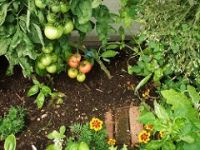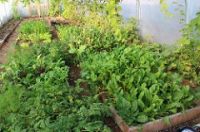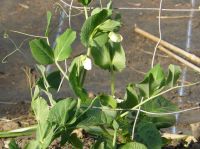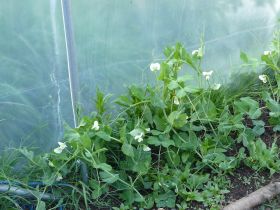How To Practice Crop Rotation In A Polytunnel
Crop rotation in a polytunnel is pretty similar to crop rotation in any other limited space, except for the fact that a polytunnel's beds can have crops in them all year round if your layout and planting schedule are well planned. Outside of course, several beds (those not containing overwintering crops or green manures) often lie empty during the winter months. In a polytunnel, your options for winter growing are wider – the extra couple of degrees of warmth that are given, even in an unheated polytunnel, can often be enough to keep off the frost, especially if other extra protection is given by cloches or horticultural fleece. This means that there are a number of crops that can happily overwinter in a polytunnel when they may not necessarily be able to do so outside where you live.
 Due to space restrictions and the fact that you will not have a fallow period in a polytunnel means that there will usually have to be compromised when it comes to crop rotation in a polytunnel. The key to preventing or at least minimising the risk of disease in your crops is to focus on the rotation of several main family groups. The family of tomatoes, one of the most popular crops to grow in a polytunnel, is one of the main groups to consider. Tomatoes, peppers, aubergines and potatoes are all in the same family and should not be grown in the same location for more than one year at a time. Ideally, you would have a four year crop rotation, though if space is limited, a three year rotation is usually sufficient for the nightshade family. When planning the layout of your polytunnel, make sure that you have at least three separate beds, each of which can be used in succession for members of this family.
Due to space restrictions and the fact that you will not have a fallow period in a polytunnel means that there will usually have to be compromised when it comes to crop rotation in a polytunnel. The key to preventing or at least minimising the risk of disease in your crops is to focus on the rotation of several main family groups. The family of tomatoes, one of the most popular crops to grow in a polytunnel, is one of the main groups to consider. Tomatoes, peppers, aubergines and potatoes are all in the same family and should not be grown in the same location for more than one year at a time. Ideally, you would have a four year crop rotation, though if space is limited, a three year rotation is usually sufficient for the nightshade family. When planning the layout of your polytunnel, make sure that you have at least three separate beds, each of which can be used in succession for members of this family.
 Brassicas should also be rotated, partly due to the risk of disease but more to protect the soil and ensure that it does not become depleted by these particularly hungry plants. Brassicas will do well when following nitrogen fixing legumes in a rotation. Since brassicas can be located in a polytunnel for a full year, it is important to make sure that you take measures to fertilise the brassica bed as you go along – legumes may play their part in a polyculture and mulches and liquid feeds will help ensure continued fertility.
Brassicas should also be rotated, partly due to the risk of disease but more to protect the soil and ensure that it does not become depleted by these particularly hungry plants. Brassicas will do well when following nitrogen fixing legumes in a rotation. Since brassicas can be located in a polytunnel for a full year, it is important to make sure that you take measures to fertilise the brassica bed as you go along – legumes may play their part in a polyculture and mulches and liquid feeds will help ensure continued fertility.
 By keeping things simple and rotating the main groups, it is likely that you will be left with 'gaps' in space and time. These gaps can be filled with other, quick growing crops. If tomatoes follow brassicas, for example, you may have enough time to fit in a quick crop of salads and radishes in the spring before things warm up. A quick crop of early peas or broad beans can be fitted in before you sow a summer crop or brassicas for overwintering. Staging can be handy for sowing winter crops ahead of time, before summer beds are vacated. Seedlings can then be planted into their final growing positions when the space is free.
By keeping things simple and rotating the main groups, it is likely that you will be left with 'gaps' in space and time. These gaps can be filled with other, quick growing crops. If tomatoes follow brassicas, for example, you may have enough time to fit in a quick crop of salads and radishes in the spring before things warm up. A quick crop of early peas or broad beans can be fitted in before you sow a summer crop or brassicas for overwintering. Staging can be handy for sowing winter crops ahead of time, before summer beds are vacated. Seedlings can then be planted into their final growing positions when the space is free.
In a garden bed you may well sow green manures to add fertility when dug in. In a polytunnel, with space at a premium, this is unlikely to be possible. Make sure you do add plenty of organic matter and organic feeds throughout the year to make sure yield does not diminish the yield as you rotate your continuous crops.
